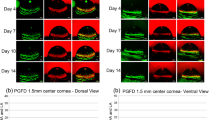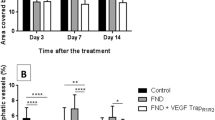Abstract
Purpose
Corneal neovascularisation (CNV), with consequent loss of transparency, is due to an imbalance of proangiogenic factors. Cell-surface nucleolin (NCL) has been associated with neo-angiogenesis. There are studies identifying NCL translocation from nucleus to the cell surface, which is essential for endothelial cell proliferation. To find the possible role of NCL in the generation of corneal neovessels, the aim of this study is to characterise the NCL presence and cell-localisation in non-injured corneas, as well as to describe the changes in NCL cell and tissue localisation in CNV, and to analyse the effect of bevacizumab on NCL cellular and tissular distribution.
Methods
Suture-induced CNV was performed in mice. The corneal tissues were obtained and the histological and co-immunofluorescence assays were performed using different proteins, such as CD31, cadherin and isolectin B4. To determine the possible role of VEGF in NCL presence and localisation in our CNV model, bevacizumab was concomitantly used.
Results
Nucleolin was principally observed in the nucleus of the basal epithelial cells of normal corneas. Interestingly, angiogenesis-induced changes were observed in the localisation of NCL, not only in tissue but also at the cellular level where NCL was extranuclear in epithelial cells, stromal cells and neovessels. In contrast, these changes were reverted when bevacizumab was used. Besides, NCL was able to stain only aberrant corneal neovessels in comparison with retinal vessels.
Conclusions
NCL mobilisation outside the nucleus during angiogenesis could have a possible role as a proangiogenic molecule in the corneal tissue.






Similar content being viewed by others
References
Bachmann B, Taylor RS, Cursiefen C (2013) The association between corneal neovascularization and visual acuity: a systematic review. Acta Ophthalmol 91:12–19
Clements JL, Dana R (2011) Inflammatory corneal neovascularization: etiopathogenesis. Semin Ophthalmol 26:235–245
Sellami D, Abid S, Bouaouaja G, Ben Amor S, Kammoun B, Masmoudi M, Dabbeche K, Boumoud H, Ben Zina Z, Feki J (2007) Epidemiology and risk factors for corneal graft rejection. Transplant Proc 39:2609–2611
Rhen T, Cidlowski JA (2005) Antiinflammatory action of glucocorticoids—new mechanisms for old drugs. N Engl J Med 353:1711–1723
Qazi Y, Wong G, Monson B, Stringham J, Ambati BK (2010) Corneal transparency: genesis, maintenance and dysfunction. Brain Res Bull 81:198–210
Razeghinejad MR, Myers JS, Katz LJ (2011) Iatrogenic glaucoma secondary to medications. Am J Med 124:20–25
You IC, Kang IS, Lee SH, Yoon KC (2009) Therapeutic effect of subconjunctival injection of bevacizumab in the treatment of corneal neovascularization. Acta Ophthalmol 87:653–658
Gupta D, Illingworth C (2011) Treatments for corneal neovascularization: a review. Cornea 30:927–938
Kim SW, Ha BJ, Kim EK, Tchah H, Kim TI (2008) The effect of topical bevacizumab on corneal neovascularization. Ophthalmology 115:e33–e38
Ochs R, Lischwe M, O’Leary P, Busch H (1983) Localization of nucleolar phosphoproteins B23 and C23 during mitosis. Exp Cell Res 146:139–149
Christian S, Pilch J, Akerman ME, Porkka K, Laakkonen P, Ruoslahti E (2003) Nucleolin expressed at the cell surface is a marker of endothelial cells in angiogenic blood vessels. J Cell Biol 163:871–878
Fogal V, Sugahara KN, Ruoslahti E, Christian S (2009) Cell surface nucleolin antagonist causes endothelial cell apoptosis and normalization of tumor vasculature. Angiogenesis 12:91–100
Huang Y, Shi H, Zhou H, Song X, Yuan S, Luo Y (2006) The angiogenic function of nucleolin is mediated by vascular endothelial growth factor and nonmuscle myosin. Blood 107:3564–3571
Shi H, Huang Y, Zhou H, Song X, Yuan S, Fu Y, Luo Y (2007) Nucleolin is a receptor that mediates antiangiogenic and antitumor activity of endostatin. Blood 110:2899–2906
Destouches D, El Khoury D, Hamma-Kourbali Y, Krust B, Albanese P, Katsoris P, Guichard G, Briand JP, Courty J, Hovanessian AG (2008) Suppression of tumor growth and angiogenesis by a specific antagonist of the cell-surface expressed nucleolin. PLoS One 3:e2518
Kleinman HK, Weeks BS, Cannon FB, Sweeney TM, Sephel GC, Clement B, Zain M, Olson MO, Jucker M, Burrous BA (1991) Identification of a 110-kDa nonintegrin cell surface laminin-binding protein which recognizes an A chain neurite-promoting peptide. Arch Biochem Biophys 290:320–325
Reyes-Reyes EM, Akiyama SK (2008) Cell-surface nucleolin is a signal transducing P-selectin binding protein for human colon carcinoma cells. Exp Cell Res 314:2212–2223
Zhuo W, Luo C, Wang X, Song X, Fu Y, Luo Y (2010) Endostatin inhibits tumour lymphangiogenesis and lymphatic metastasis via cell surface nucleolin on lymphangiogenic endothelial cells. J Pathol 222:249–260
Bates PJ, Laber DA, Miller DM, Thomas SD, Trent JO (2009) Discovery and development of the G-rich oligonucleotide AS1411 as a novel treatment for cancer. Exp Mol Pathol 86:151–164
Birmpas C, Briand JP, Courty J, Katsoris P (2012) The pseudopeptide HB-19 binds to cell surface nucleolin and inhibits angiogenesis. Vasc Cell 4:21
Destouches D, Page N, Hamma-Kourbali Y, Machi V, Chaloin O, Frechault S, Birmpas C, Katsoris P, Beyrath J, Albanese P, Maurer M, Carpentier G, Strub JM, Van Dorsselaer A, Muller S, Bagnard D, Briand JP, Courty J (2011) A simple approach to cancer therapy afforded by multivalent pseudopeptides that target cell-surface nucleoproteins. Cancer Res 71:3296–3305
Rosenberg JE, Bambury RM, Van Allen EM, Drabkin HA, Lara PN Jr, Harzstark AL, Wagle N, Figlin RA, Smith GW, Garraway LA, Choueiri T, Erlandsson F, Laber DA (2014) A phase II trial of AS1411 (a novel nucleolin-targeted DNA aptamer) in metastatic renal cell carcinoma. Investig New Drugs 32:178–187
Shi W, Ming C, Liu J, Wang T, Gao H (2011) Features of corneal neovascularization and lymphangiogenesis induced by different etiological factors in mice. Graefes Arch Clin Exp Ophthalmol 249:55–67
Rocher N, Behar-Cohen F, Pournaras JA, Naud MC, Jeanny JC, Jonet L, Bourges JL (2011) Effects of rat anti-VEGF antibody in a rat model of corneal graft rejection by topical and subconjunctival routes. Mol Vis 17:104–112
Benayoun Y, Rosenberg R, Casse G, Dallaudiere B, Robert PY (2013) Imaging and quantification of corneal neovascularization. J Fr Ophtalmol 36:693–703
Ververis K, Marzully S, Samuel CS, Hewitson TD, Karagiannis TC (2016) Qualitative and quantitative analysis of histone deacetylases in kidney tissue sections. Methods Mol Biol 1397:279–289
Tual-Chalot S, Allinson KR, Fruttiger M, Arthur HM (2013) Whole mount immunofluorescent staining of the neonatal mouse retina to investigate angiogenesis in vivo. J Vis Exp: e50546.
Haddad A, Faria-e-Sousa SJ (2014) Maintenance of the corneal epithelium is carried out by germinative cells of its basal stratum and not by presumed stem cells of the limbus. Braz J Med Biol Res 47:470–477
Ugrinova I, Monier K, Ivaldi C, Thiry M, Storck S, Mongelard F, Bouvet P (2007) Inactivation of nucleolin leads to nucleolar disruption, cell cycle arrest and defects in centrosome duplication. BMC Mol Biol 8:66
Xu Z, Joshi N, Agarwal A, Dahiya S, Bittner P, Smith E, Taylor S, Piwnica-Worms D, Weber J, Leonard JR (2012) Knocking down nucleolin expression in gliomas inhibits tumor growth and induces cell cycle arrest. J Neuro-Oncol 108:59–67
Otake Y, Soundararajan S, Sengupta TK, Kio EA, Smith JC, Pineda-Roman M, Stuart RK, Spicer EK, Fernandes DJ (2007) Overexpression of nucleolin in chronic lymphocytic leukemia cells induces stabilization of bcl2 mRNA. Blood 109:3069–3075
Jester JV, Lee YG, Huang J, Houston J, Adams B, Cavanagh HD, Petroll WM (2007) Postnatal corneal transparency, keratocyte cell cycle exit and expression of ALDH1A1. Invest Ophthalmol Vis Sci 48:4061–4069
Cho KS, Joo CK, Williams JS, Ambroziak BS, Bassnett SS, Pepose JS, Fleming TP (2000) Stimulation of quiescent corneal endothelial cells by direct delivery of the SV40 large T-antigen protein. Curr Eye Res 20:58–63
Muller M, Hutin S, Marigold O, Li KH, Burlingame A, Glaunsinger BA (2015) A ribonucleoprotein complex protects the interleukin-6 mRNA from degradation by distinct herpesviral endonucleases. PLoS Pathog 11:e1004899
Srivastava M, Pollard HB (1999) Molecular dissection of nucleolin’s role in growth and cell proliferation: new insights. FASEB J 13:1911–1922
Garcia MC, Williams J, Johnson K, Olden K, Roberts JD (2011) Arachidonic acid stimulates formation of a novel complex containing nucleolin and RhoA. FEBS Lett 585:618–622
Mediero A, Crooke A, Guzman-Aranguez A, Pintor J (2011) Phospholipase C/Protein Kinase C pathway is essential for corneal re-epithelialization induced by Ap(4)A. Curr Eye Res 36:1108–1115
Hovanessian AG, Soundaramourty C, El Khoury D, Nondier I, Svab J, Krust B (2010) Surface expressed nucleolin is constantly induced in tumor cells to mediate calcium-dependent ligand internalization. PLoS One 5:e15787
Wang Y, Mao M, Xu JC (2011) Cell-surface nucleolin is involved in lipopolysaccharide internalization and signalling in alveolar macrophages. Cell Biol Int 35:677–685
Qiu W, Zhou F, Zhang Q, Sun X, Shi X, Liang Y, Wang X, Yue L (2013) Overexpression of nucleolin and different expression sites both related to the prognosis of gastric cancer. APMIS 121:919–925
Xu JY, Lu S, Xu XY, Hu SL, Li B, Li WX, Chang JY (2016) Prognostic significance of nuclear or cytoplasmic nucleolin expression in human non-small cell lung cancer and its relationship with DNA-PKcs. Tumour Biol. doi:10.1007/s13277-016-4920-6
Jackson JR, Seed MP, Kircher CH, Willoughby DA, Winkler JD (1997) The codependence of angiogenesis and chronic inflammation. FASEB J 11:457–465
Ambati BK, Nozaki M, Singh N, Takeda A, Jani PD, Suthar T, Albuquerque RJ, Richter E, Sakurai E, Newcomb MT, Kleinman ME, Caldwell RB, Lin Q, Ogura Y, Orecchia A, Samuelson DA, Agnew DW, St Leger J, Green WR, Mahasreshti PJ, Curiel DT, Kwan D, Marsh H, Ikeda S, Leiper LJ, Collinson JM, Bogdanovich S, Khurana TS, Shibuya M, Baldwin ME, Ferrara N, Gerber HP, De Falco S, Witta J, Baffi JZ, Raisler BJ, Ambati J (2006) Corneal avascularity is due to soluble VEGF receptor-1. Nature 443:993–997
Varricchi G, Granata F, Loffredo S, Genovese A, Marone G (2015) Angiogenesis and lymphangiogenesis in inflammatory skin disorders. J Am Acad Dermatol 73:144–153
Angel-Morales G, Noratto G, Mertens-Talcott S (2012) Red wine polyphenolics reduce the expression of inflammation markers in human colon-derived CCD-18Co myofibroblast cells: potential role of microRNA-126. Food Funct 3:745–752
Noack F, Sotlar K, Thorns C, Smrcek J, Diedrich K, Feller AC, Horny HP (2003) VEGF-, KIT protein- and neutral endopeptidase (NEP/CD10)-positive myofibroblasts-precursors of angiogenesis in chorioangiomas? Placenta 24:758–766
Boscia F, Esposito CL, Casamassa A, de Franciscis V, Annunziato L, Cerchia L (2013) The isolectin IB4 binds RET receptor tyrosine kinase in microglia. J Neurochem 126:428–436
Dominguez-Lopez A, Bautista-de Lucio VM, Serafin-Lopez J, Robles-Sanchez E, Garfias Y (2014) Amniotic membrane modulates innate immune response inhibiting PRRs expression and NF-kappaB nuclear translocation on limbal myofibroblasts. Exp Eye Res 127:215–223
Koutsioumpa M, Papadimitriou E (2014) Cell surface nucleolin as a target for anti-cancer therapies. Recent Pat Anticancer Drug Discov 9:137–152
Acknowledgments
The authors wish to thank Juan E. Jiménez and Mohamed Ali Pereyra Morales for their technical support. Joaquín Quiroz-Mercado received a scholarship from CONACYT-CVU: 315182. This article is part of the requirements for the Doctoral Degree of Joaquín Quiroz-Mercado in the “Programa de Doctorado en Producción Animal y Ciencias de la Salud, Facultad de Medicina Veterinaria y Zootecnia, UNAM”.
The authors have full control over all primary data and they agree to allow Graefes Archive for Clinical and Experimental Ophthalmology to review their data upon request.
Author information
Authors and Affiliations
Corresponding author
Ethics declarations
Funding
CONACYT SALUD-160286; 71291, CONACYT-SEP-CIENCIA-BASICA 167438, DGAPA UNAM-PAPIIT IA203514 and Conde de Valenciana Foundation provided financial support in the form of grants. The sponsor had no role in the design or conduct of this research.
Conflict of interest
All authors certify that they have no affiliations with or involvement in any organisation or entity with any financial interest (such as honoraria; educational grants; participation in speakers’ bureaus; membership, employment, consultancy, stock ownership, or other equity interest; or expert testimony or patent-licencing arrangements) or non-financial interest (such as personal or professional relationships, affiliations, knowledge or beliefs) in the subject matter or materials discussed in this manuscript.
Ethical approval
All applicable international, national and institutional guidelines for the care and use of animals were followed. All procedures were in accordance with the ethical standards of the Instituto de Oftalmología Conde de Valenciana.
Rights and permissions
About this article
Cite this article
Quiroz-Mercado, J., Ramírez-Velázquez, N., Partido, G. et al. Tissue and cellular characterisation of nucleolin in a murine model of corneal angiogenesis. Graefes Arch Clin Exp Ophthalmol 254, 1753–1763 (2016). https://doi.org/10.1007/s00417-016-3409-8
Received:
Revised:
Accepted:
Published:
Issue Date:
DOI: https://doi.org/10.1007/s00417-016-3409-8




